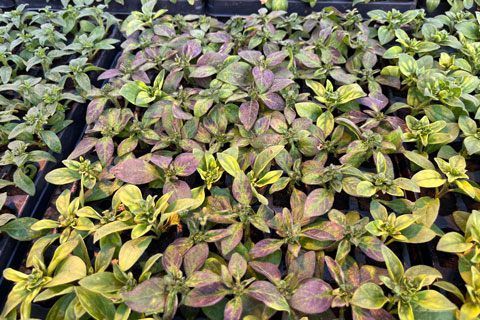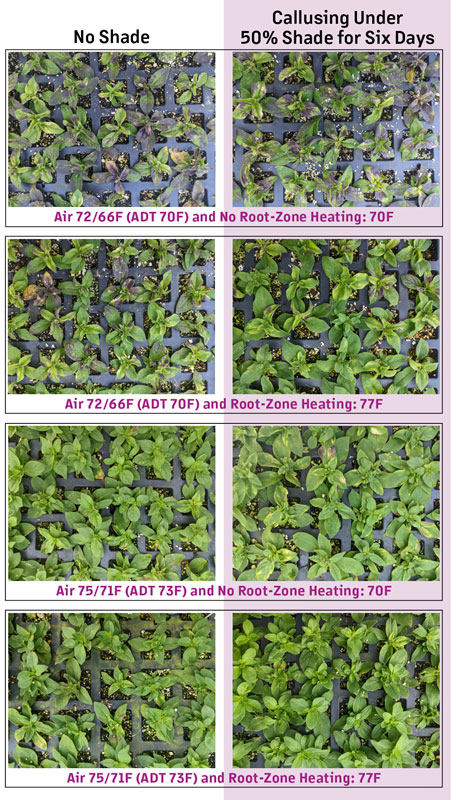11/1/2023
The Problem With Purple
Charlie Smith, Nathan Jahnke, Colin Brice & Roberto Lopez

Most young plant production occurs from January to March, which coincides with some of the shortest and cloudiest days of the year, and consequently very low light environments in the greenhouse.
Let’s step back 20 years when research began at Michigan State University (MSU) to determine why it was taking growers six-plus weeks to root New Guinea impatiens cuttings. We quickly found that by providing 50 to 70 µmol·m-2·s-1 of supplemental lighting during rooting stages 3 and 4 (rooting and toning) from high-pressure sodium (HPS) lamps, we could double the photosynthetic daily light integral (DLI) from 4 to 8 mol·m-2·d-1 in January. By March, we could go up to 12 mol·m-2·d-1 and reduce rooting time by up to three weeks! The general recommendation for rooting of cuttings was to provide a DLI of 4 to 5 mol·m-2·d-1 during stages 1 and 2 (stick and callusing) and then 8 to 12 mol·m-2·d-1 during stages 3 and 4.
Today, most rooting stations and young plant propagators have LED supplemental lighting fixtures that provide anywhere from 80 to 120 µmol·m-2·s-1 of supplemental light. Why? LEDs are over 3.5 times more efficient at converting electricity into photons of light that plants can use for photosynthesis than the 400-watt HPS lamps they replaced. Additionally, they’re long-lasting and they’re said to be generally safer for users and the environment.
As more propagators installed LEDs and the intensities provided during young plant production increased, so did the inquiries and concerns about chlorosis and development of purple pigmentation on cuttings of certain genera and cultivars of petunia and other crops after a week or so under the LEDs (Figure 1). This led MSU, Ball Horticultural Company and Philips Horticulture LED Lighting to develop studies to determine: 1) if cuttings placed under LEDs developed nutrient deficiencies; 2) if foliage pigmentation is caused by an accumulation of anthocyanins; and 3) how to prevent the undesirable foliage color.

The study
Cuttings of three Petunia × hybrida cultivars from the SureShot series Dark Blue, Dark Red, White and Supertunia Vista Fuchsia were received and immediately stuck in 72-cell trays containing loose-fill peat and perlite media in January and February 2023.
Upon stick to 10 days after stick, cuttings were provided with overhead mist containing a water-soluble fertilizer [ (in mg∙L-1) 60 N, 23 P, 60 K, 27.7 Ca, 4.6 Mg, 1.3 Fe, 0.6 Mn, 0.6 Zn, 0.6 Cu, 0.4 B and 0.1 Mo] based on the greenhouse accumulated light. A vapor pressure deficit (VPD) of 0.3 kPa was maintained with the injection of steam.
Air and root-zone heating treatments: The trays of cuttings were placed in one of two glass-glazed greenhouse compartments with day and night air temperature setpoint of 75/70F [average daily temperature (ADT) of 73F] or 72/66F (ADT of 70F) and on top of individual benches that were divided in half to provide root-zone heating (RZH; Biotherm Benchwarmer Kit) or no RZH to maintain a root-zone temperature of either 70 or 77F, respectively.
Supplemental lighting treatments: To achieve a DLI of 10 to 12 mol·m-2·d-1, HPS lamps or LEDs that provided a ratio (%) of blue (B):Green (G):Red (R):Far-red (FR) light of 8:6:85:1 or 11:6:82:1 (Philips Green Power Toplighting Linear) delivered a light intensity of 120 µmol·m-2·s-1 of supplemental light from 6:00 a.m. to 10:00 p.m. based on a lighting threshold. Cuttings were either immediately stuck under one of the lighting fixtures previously mentioned to receive a DLI of 10 to 12 mol·m-2·d-1 or they were placed under a PVC structure with 50% shade cloth for six days of callusing under a DLI of 5 to 6 mol·m-2·d-1.
Data collection: Rooted cuttings were harvested 22 days after stick. Stem length and caliper data were taken on the day of harvest. Sampled cuttings were then separated into roots and shoots, dried, and weighed to record the root dry mass (RDM) and shoot dry mass (SDM). Additionally, tissue samples for macronutrient, micronutrient and anthocyanin concentration analyses were taken and sent to an analytical laboratory for processing.
What we found
All petunia cultivars investigated were significantly more compact when rooted under either of the LED fixtures. However, there were no differences in RDM or time to finish a liner. The foliage of Petunia SureShot White and Red developed minimal chlorosis under HPS lamps providing 120 µmol·m-2·s-1 of supplemental light and significantly more under LEDs when the air and root-zone temperature were <73F. However, within seven to 10 days after stick, the foliage color of Petunia SureShot Blue and Supertunia Vista Fuchsia developed foliage purpling under HPS lamps and severe purpling under the LEDs (Figure 2). These symptoms were exacerbated when cuttings were placed under a DLI of 10 to 12 mol·m-2·d-1, no root-zone heating and an air ADT of 70F. Visually, cuttings exhibited the most severe purpling symptoms under LEDs (Figure 2) and this was confirmed with Petunia SureShot Blue having the highest anthocyanin concentrations under these treatments.
It’s important to note that plants synthesize anthocyanins, the red and blue pigments found in flowers and leaves, to counteract oxidative damage from environmental stresses, such as exposure to high light intensities, certain wavelengths of photosynthetically active radiation and ultraviolet radiation, chilling injury, phosphorus nutrient deficiency, wounding, and pathogen infection.
Cutting tissue concentrations of nitrogen, phosphorus, potassium, magnesium, iron and sodium were generally the lowest when cuttings were rooted under LEDs and not provided with a callusing treatment (lower DLI of 5 to 6 mol·m-2·d-1 during stages 1 and 2) or root-zone heating and in a greenhouse with an air ADT of 70F.
Are you asking yourself, why did we not see these symptoms in the past under HPS lamps? Well, in the past we generally never provided up to 120 µmol·m-2·s-1 of supplemental light. As the intensities increased, LEDs were now contributing to the majority of the total DLI, as was the case during the winter of 2022.
Additionally, the energy efficiency of LEDs results in less radiant heat transfer to plant leaf surfaces. Therefore, if air temperatures aren’t slightly increased and/or directed root-zone heat isn’t provided to the plants, actual leaf temperature and transpiration can become limiting factors to successful rooting. Therefore, when rooting cuttings under LED fixtures, provide a root-zone temperature of 75 to 77F and/or an air ADT of 73F to prevent chlorosis and purpling (Figure 2).
It may seem counterintuitive to increase the air and/or root-zone temperature under LEDs—it is not! While there might be additional energy costs for heating, the energy being applied is directed heat that’s uniform and controlled by the grower, which isn’t the case with HPS lamps, as they’re an inefficient way of heating your greenhouse.
Recommendations
If you’re rooting your cuttings under LEDs and they’re developing some chlorosis or purpling, try one or two of these recommendations to see which will work for your operation:
■ Increase the air average daily temperature by a few degrees
■ Utilize a root-zone heating system to maintain a root-zone temperature of 75 to 77F
Try to maintain a DLI of 5 to 6 mol·m-2·d-1 during stages 1 and 2 by placing cuttings under shade tents for acclimatization or reduce your supplemental light intensity during this time. If shade tents aren’t feasible to deploy, dimming your LEDs or reducing lighting hours can also effectively reduce the total DLI provided to the plants. GT
Acknowledgements: We thank J.R. Peters for fertilizer, Ball Horticultural Company for cuttings and anthocyanin analysis, Philips Horticulture LED Lighting for supplemental lighting fixtures, East Jordan Plastics for trays, Ludvig Svensson for shade curtains; and The Metro Detroit Flower Growers Association, Philips Horticulture LED Lighting and Ball Horticultural Company for financial support.
Roberto Lopez is an Associate Professor and Controlled Environment/Floriculture Extension Specialist and Charlie Smith is an M.S. student in the Department of Horticulture at Michigan State University. Nathan Jahnke is a Culture Research Manager at Ball Horticultural Company, and Colin Brice is a Plant Specialist and Key Account Manager at Philips Horticulture LED Solutions.